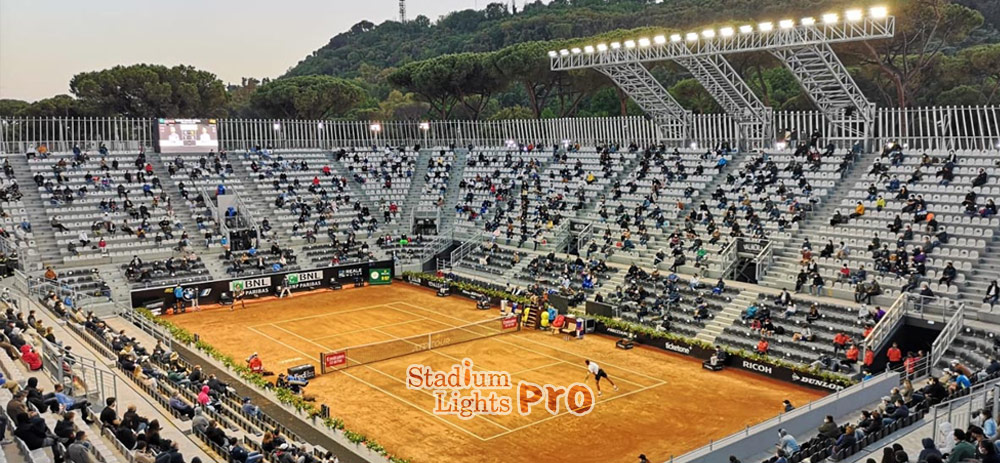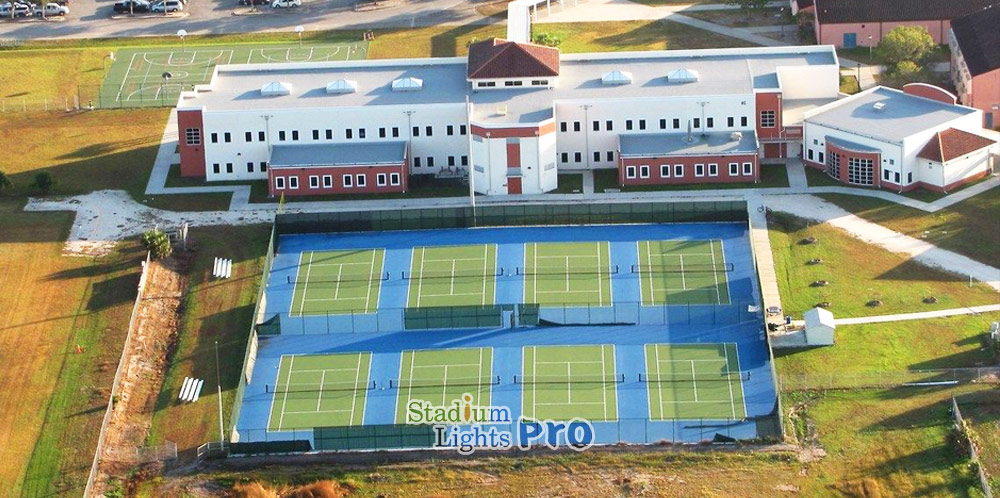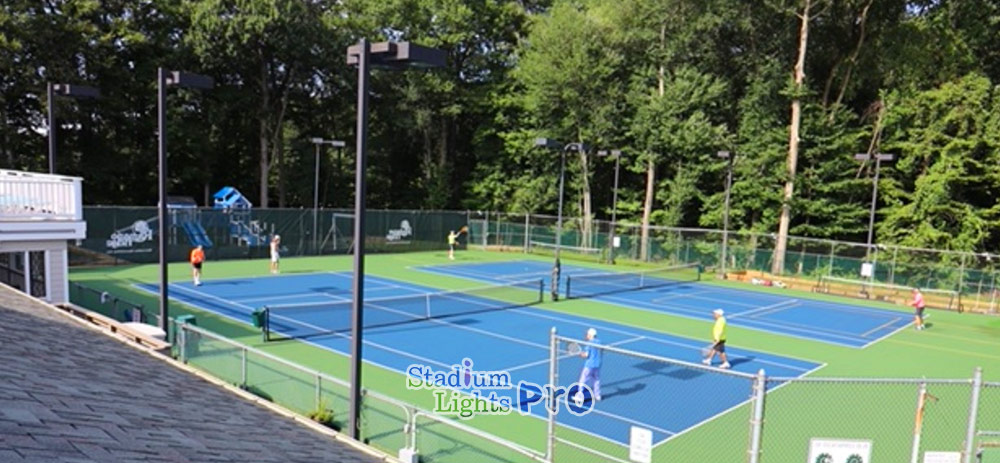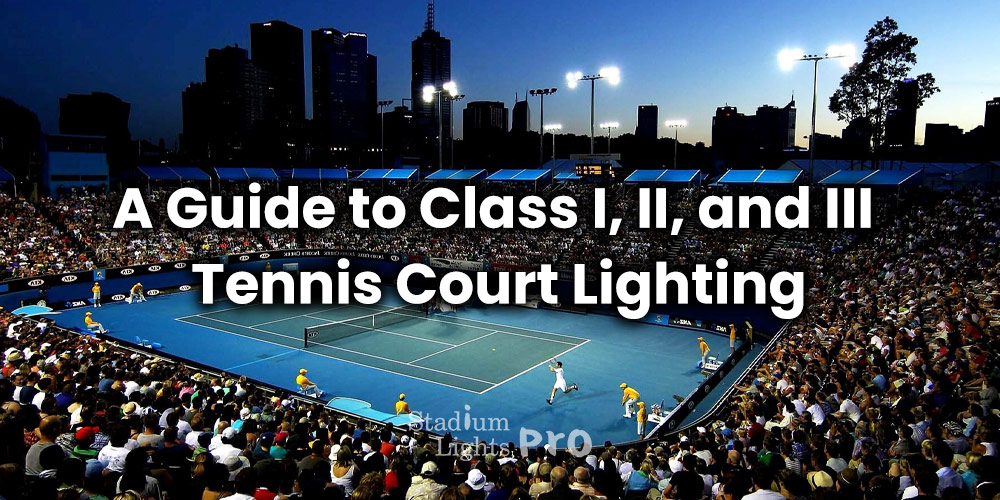Proper lighting is essential for any tennis court, as it helps to ensure visibility and safety for players. In this guide, we will explore the three classes of tennis courts and their lighting requirements, including recommended levels of illumination and the types of lighting fixtures commonly used. Whether you are a club owner, a tournament organizer, or a recreational player, this information will help you choose the best lighting solution for your court, based on its class and intended use.
Table of Contents
ToggleClass I Tennis Court Lighting
Definition of Class I courts

Class I tennis courts are the highest quality and most expensive to construct. They are typically found at clubs and high-level tournaments, and are designed to provide the most consistent and true playing surface. Class I courts have a surface layer made of acrylic or other synthetic material on top of a base of asphalt or concrete. The surface layer is applied in a thin, uniform layer and is designed to provide good ball bounce and grip, as well as good drainage. The base layer provides a stable, durable foundation for the court, and may be reinforced with a layer of steel or other material to improve its strength and stability.
Class I courts are often used for professional and high-level amateur tournaments, as well as for recreational play at private clubs and other facilities. They have a consistent and true playing surface, which enables high-level play and accurate ball movement. However, Class I courts are also the most expensive to maintain, as the surface layer needs regular resurfacing and the base layer may need to be repaired or replaced eventually. Despite the costs, many players and facilities consider Class I courts to be a worthwhile investment due to their superior playability and durability.
Recommended lighting levels for Class I courts
Class I tennis courts require lighting levels of at least 500 to 750 lux (a measure of illumination) on the playing surface, with a minimum uniformity ratio of 1.5:1. This means that the difference in lighting levels between the brightest and darkest areas of the court should not exceed 1.5 times the average lighting level. These lighting levels are recommended by the International Tennis Federation (ITF) and are intended to provide good visibility and safety for players.
These lighting levels are minimum standards, and some courts may choose to install lighting systems that exceed these levels in order to improve visibility and playability. Additionally, the actual lighting levels and uniformity ratios may vary depending on the specific design and layout of the court. Factors such as the height and orientation of the lighting fixtures, the surface material of the court, and the surrounding environment can all affect the overall lighting performance of the court. Consult with a lighting specialist or engineer to determine the optimal lighting solution for your Class I court.
Class II Tennis Court Lighting
Definition of Class II courts

Class II tennis courts are intermediate in terms of construction and are often found at public parks or schools. They have a surface layer made of asphalt or concrete, but may not be as smooth or consistent as Class I courts. The surface layer may be applied in a thicker layer than on Class I courts, and may not be as tightly bonded to the base layer. As a result, Class II courts may not provide the same level of ball bounce and grip as Class I courts, and may be more prone to cracking or other surface defects.
Class II courts are usually designed for less competitive play, such as high schools and community centers. They are less expensive to construct and maintain than Class I courts, and are suitable for a wide range of players and skill levels. Despite their lower quality, Class II courts can still provide a good playing experience for most players, and are a popular choice for recreational facilities due to their lower cost and ease of maintenance.
Recommended lighting levels for Class II courts
Class II tennis courts require lighting levels of at least 300 to 500 lux on the playing surface, with a minimum uniformity ratio of 2:1.
Class III Tennis Court Lighting
Definition of Class III courts

Class III tennis courts are the least expensive to construct and are typically found at community centers or other recreational facilities. They may have a surface made of asphalt, concrete, or even a type of synthetic turf. Class III courts may not have the same level of surface smoothness or consistency as Class I or II courts, and may not provide the same level of ball bounce and grip. They are also more prone to surface defects and damage, and may require more frequent maintenance and repair.
Class III courts are used for recreational play at public facilities, such as tennis club and parks. They are the least expensive to construct and maintain, and are suitable for a wide range of players and skill levels. Despite their lower quality, Class III courts can still provide a good playing experience for most players, and are a popular choice for recreational facilities due to their low cost and ease of maintenance.
Recommended lighting levels for Class III courts
Class III tennis courts require lighting levels of at least 200 to 300 lux on the playing surface, with a minimum uniformity ratio of 3:1.
Other Considerations for Tennis Court Lighting
Energy efficiency and cost-saving options
Tennis courts can be expensive to light, especially if they are used for long hours or during the night. Consider using energy-efficient lighting fixtures, such as LED lamps, to reduce energy consumption and lower operating costs. You may also want to consider installing dimming or timer controls to allow you to adjust the lighting levels based on the time of day and level of activity on the court.
Safety and visibility for players
Proper lighting is essential for the safety of players, as it helps to prevent accidents and injuries due to poor visibility. Make sure that the lighting system is designed to provide adequate illumination and uniformity across the entire playing surface, and consider installing additional lighting in areas where players may be more likely to collide or trip, such as near the net or at the corners of the court.
Maintenance and repair of lighting fixtures
Tennis courts can be exposed to harsh weather conditions and wear and tear, which can take a toll on lighting fixtures. Make sure to select lighting fixtures that are durable and capable of withstanding the elements, and consider using fixtures with a long lifespan to reduce maintenance and replacement costs. It’s also a good idea to have a maintenance plan in place to ensure that the lighting system is regularly checked and repaired as needed.
Conclusion
Class I, Class II, and Class III, based on their surface material, construction, and intended use. Each class of court has its own specific requirements for lighting, including recommended levels of illumination and uniformity ratios, as well as recommended types of lighting fixtures. In addition to these requirements, there are several other considerations to keep in mind when designing and installing a lighting system for a tennis court, including energy efficiency, safety and visibility for players, and maintenance and repair of lighting fixtures. By considering these factors, you can choose the best lighting solution for your tennis court, based on its class and intended use.
If you are considering installing or upgrading the lighting on your tennis court, we encourage you to contact us for a free lighting design consultation. Our team of lighting specialists has extensive experience in designing and installing lighting systems for tennis courts of all classes, and we can help you choose the best lighting solution for your facility. We offer a variety of lighting options to suit your needs and budget, including energy-efficient LED lamps, dimming and timer controls, and solar panels. Contact us today to learn more and get started on your lighting project.

